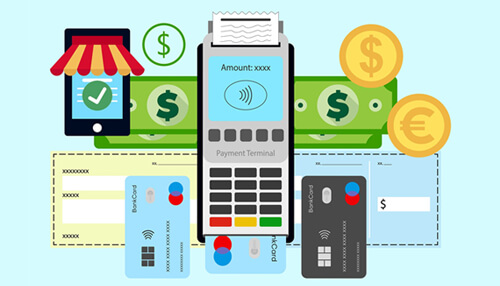Our lives have changed in recent years in almost every aspect. Technology and the internet have infiltrated our lives and, in most cases, changed them for the better. We could stop wasting our time on many irrelevant things as now we could do it quicker and easier than before; this left us with more time to concentrate on the important ones. It made a difference in almost every aspect of our lives, but the most significant change happened considering the financial element. Not only we are becoming a cashless society and cash is becoming a thing of the past, with five in six payments now involving no notes or coins, and e-wallets became more popular than ever, but we can also pay a bill with just the tap of your watch.
This completely changed the way companies from different industries conduct their business. Online shopping and eCommerce have experienced incredible growth, cryptocurrency exchanges became more popular with new coins constantly being developed, and it even made it easier for gaming and gambling industries to reach their clientele. These are not the only businesses that have undergone a digital transformation process and accepted the opportunities online payments can offer them. With the development of technology, more and more industries will begin to join them in the digital world. Sadly, companies are not the only ones that can experience the benefits of online transactions, as cybercriminals and fraudsters are constantly finding new ways of exploiting them. This is why every company must be aware of the online danger and the proper steps they can take to fight against it.
Online dangers in the modern world
Unfortunately, criminals are constantly trying to devise new ways of exploiting businesses and individuals for their own benefit. This is nothing new as fraudsters always followed the profit, and now it has taken to the online world putting all businesses with an online presence in danger. While there are different risks companies can face, the truth is that one of the biggest issues is unknowingly becoming involved in criminal activities such as money laundering, terrorist financing, human trafficking, or corruption. In the past, this was an issue only financial institutions had to deal with, but today criminals are targeting any business dealing with finances. Preventing this is no longer an option but a must for any company that wants to stay in business. Taking the proper steps, such as implementing AML transaction monitoring, can make all the difference.
What is Anti-money laundering transaction monitoring (AML)?
Any business dealing with finances faces the danger of financial fraud, which is why they must implement transaction monitoring into their security strategy. Anti-money laundering transaction monitoring allows companies to monitor transactions in real-time to determine their risk factor. This will enable them to identify and prevent any suspicious transaction that might indicate financial crime before it can endanger the company and the customer. Anti-money laundering transaction monitoring is especially useful when combined with an analysis of the customers and their account history. It allows companies to get a clearer picture about the user and their risk factors. By learning more about the customers, it would be easier to notice any suspicious behavior that differentiates from the usual one. Not only does this allow businesses to stay safe, but also that they stay compliant with AML / CTF or Anti-Money Laundering/Combating the Financing of Terrorism regulations.
Why do you need transaction monitoring in your business?
Any business is in danger of becoming a victim of different types of fraudulent actions, but the risks get even higher when the business is dealing with finances. Criminals constantly look for an opportunity to exploit companies for their benefit, and the sudden increase in online transactions has allowed them to expand their reach. While some will try to steal your money, intellectual property, or even confidential data, others will try to exploit your business for money laundering, terrorism financing, arms trading, human trafficking, or corruption. This is why international organizations have decided to end it and created a set of AML and CTF regulations that utilize severe fines to ensure all businesses comply with them. Using transaction monitoring will not only help with avoiding those fines but also with other aspects of the business operations.
Transaction monitoring allows companies to:
- Ensure they stay compliant with AML / CTF regulations
- Prevent different types of fraudulent activity such as identity theft or account takeover by recognizing discrepancies in a customer’s behavior
- Reduce false positives
- Implement real-time monitoring reducing the user friction
- Reduce the financial and time burden of manual reviews.
- Prevent long-term consequences such as reputational damage
While the primary purpose of financial monitoring is to prevent financial crime, it is essential to remember all the other benefits it will bring to your business.
How does it work?
Banks have been using transaction monitoring for a long time, which is why most of us have already experienced it in our personal lives. While we might’ve been annoyed by the banks asking us to confirm we have authorized a certain transaction or if they blocked your card when you tried to use it in a different country, at the same time, we were happy knowing they are keeping us safe. That is how transaction monitoring works; it analyzes every transaction that goes through the system, compares it with the user’s previous account behavior, and runs it through the set of rules the company has provided. After assessing all the elements and determining risk factors, it flags any suspicious behavior. For example, a transaction might be coming through a high-risk country or is over a certain threshold that is standard for that business, which raises some red flags. By assessing the risk in real-time, companies can react momentarily and stop criminals before they can do any damage.
Conclusion
Real-time payments and criminals trying to exploit them are not going away soon. Luckily, we do not have to accept the danger as there are solutions that can keep us safe such as real-time transaction monitoring. This security strategy allows companies to actively protect their business and customers from financial crimes such as money laundering and terrorism financing while ensuring they stay compliant with government regulations. Online safety is everyone’s responsibility, and it is the end time the companies start to take an active role in ensuring we are all safe when conducting our financial activities online.



